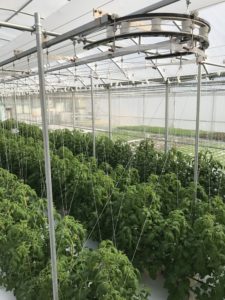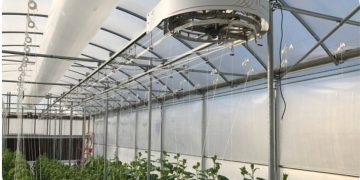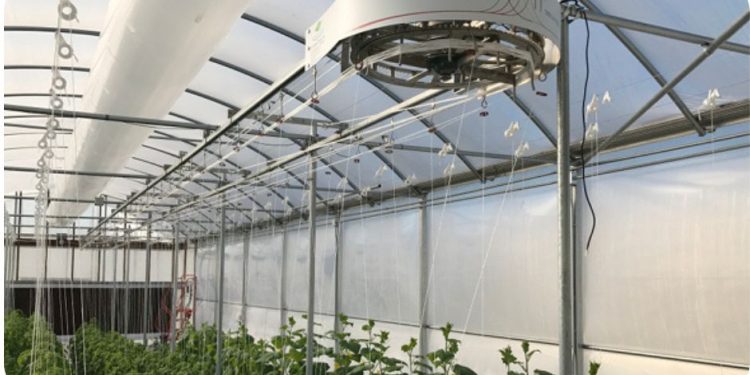A startup Michigan company is offering a back-saving device for easing down tomato vines that have grown to the top of the greenhouse.
The Summit Trellis System by Still Water Designs leans and lowers entire rows of tomatoes with the press of a button. Many tomato growers know the work to be tedious and backbreaking. Plants weigh up to 20 pounds, and a greenhouse may hold as many as 200 plants that will require climbing up and down a ladder or stepstool.
For greenhouse grower Dwight Carpenter, the idea for Summit Trellis System was borne out of many long days of work and a trip to a growers’ convention when nobody could think of a better way to simplify the job.
“I was at a convention seminar, and the guys were talking about how the main cost and headache is leaning and lowering,” Carpenter said. “You’ve got to get way up to do it, and it’s hard on your shoulders and hard on your back.”
He continued to grow tomatoes, but the question didn’t go away.
“I just kept on thinking about it and thinking about it,” Carpenter said. In the early 2000s, brainstorming and talks with fellow grower Keith Jenema led to construction of a hand-crank device built from a sawed-in-half Schwinn bicycle.
That contraption remained undiscovered at Carpenter’s Greenhouses in Allen, Michigan for a while before it was noticed in 2015 by two younger men who were interested in greenhouses for vegetable growing. Childhood friends Ben Netz and Andy Herweyer, were IT professionals looking for a career switch and had been talking to Andy’s father, Dick Herweyer, who also operated a small greenhouse on the side.
“(Carpenter) showed us the whole operation, this is how we do organic and this is how we do hydroponic,” Netz said. “Kind of in between there, we noticed something, some kind of machine he had slapped together.”
Netz showed it to an engineer friend who saw a lot of potential in the project: It was a new design that seemed to solve a real problem.
Ben, Andy and Dick are now co-partners with Jenema and Carpenter in Still Water Designs, the group that’s bringing the Summit Trellis system to market. All five partners have ties to the small town of McBain, Michigan and knew each other well.
The Summit system uses an overhead metal track and spindle system to shift the plants at the push of a button.
“It’s a time saver, and a shoulder saver,” Carpenter said.
Development wasn’t a piece of cake, although there was some dessert involved. The team cycled through three different prototypes, and spent late nights working out bugs in the system, which had to be geared to smoothly handle the tomatoes so none fell. At one point, the group worked on a prototype hooked to production tomatoes on a 186-foot row in Carpenter’s greenhouse. The device repeatedly failed over the course of the day, first shifting the tomatoes much too far, and then lowering the tomatoes instead of holding them up.
“At that point, Dwight said, ‘Let’s go have dinner now – and some pie,’” Netz said. After dinner, the group worked until 1:30 a.m. to get the device working properly.
The group says the resulting device is versatile, useable for rows 10 to 300 feet long, and with applications for other crops that require a trellis, such as cucumbers, beans and hops.
At this point, the devices are being built on a custom order basis, so the group isn’t listing prices. A demonstration unit has been installed at CropKing in Lodi, Ohio.
“It is unique to the industry,” said CropKing CEO Paul Brentlinger. “There are some similar type systems used in the hanging baskets but nothing I’ve seen for leaning and lowering tomato plants. Whenever somebody sees it they are always excited and impressed, especially if they are a tomato grower who has experienced leaning and lowering.”
Brentlinger said the device is still in the testing phase at CropKing before being sold there. In the meantime, Netz said, the device is available directly from Still Water Designs.

CropKing in Lodi, Ohio.
Still Water took a unit on the road to July’s Cultivate trade show in Columbus and exhibited at December’s Great Lakes Fruit, Vegetable and Farm Market EXPO in Grand Rapids.
(Keith) said that at the earlier trade show, a grower from Japan grew excited when seeing video of the task it was designed to replace. “That’s me,” she said, and managed to communicate that she did the same work, repeatedly tilting and lowering trellis plants.
Andy Herweyer said the trellis system sells itself.
“The ones who do the job know exactly how bad it is,” he said. “And then they see the machine and say, ‘That’s the fix.’”
— Stephen Kloosterman, VGN assistant editor
Above: Still Water Designs is selling a greenhouse trellis system. Photos: Still Water Designs

































